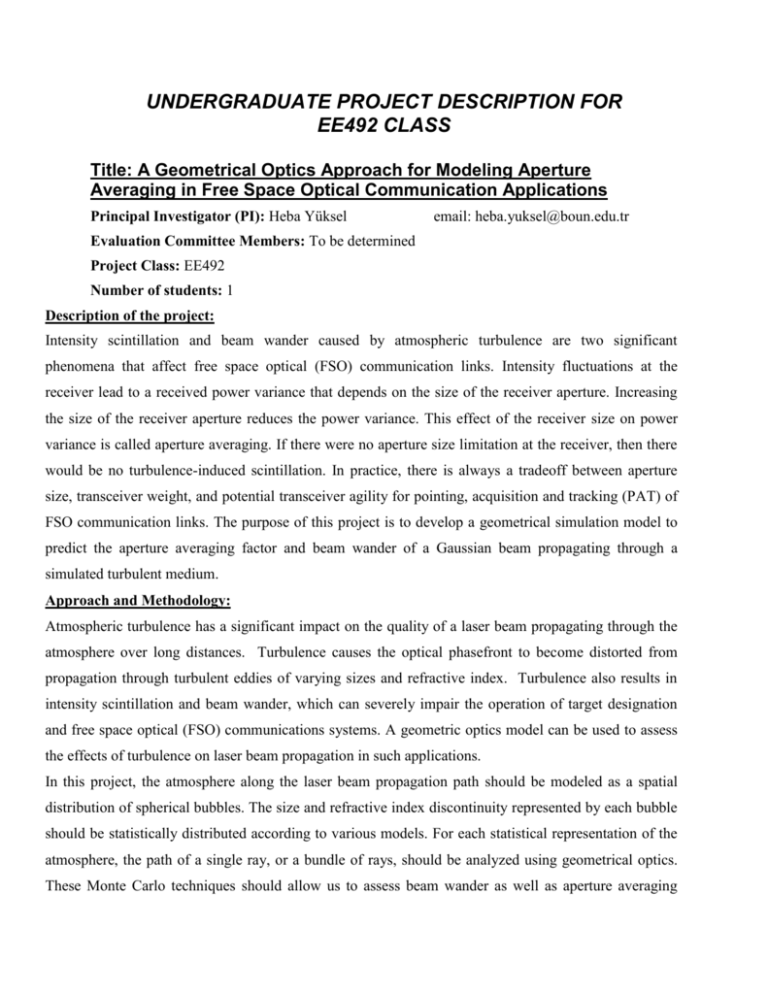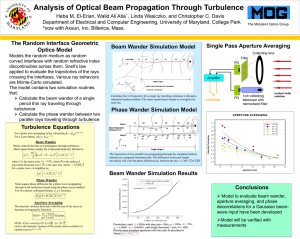Description ModelingAtmosphericTurbulence
advertisement

UNDERGRADUATE PROJECT DESCRIPTION FOR EE492 CLASS Title: A Geometrical Optics Approach for Modeling Aperture Averaging in Free Space Optical Communication Applications Principal Investigator (PI): Heba Yüksel email: heba.yuksel@boun.edu.tr Evaluation Committee Members: To be determined Project Class: EE492 Number of students: 1 Description of the project: Intensity scintillation and beam wander caused by atmospheric turbulence are two significant phenomena that affect free space optical (FSO) communication links. Intensity fluctuations at the receiver lead to a received power variance that depends on the size of the receiver aperture. Increasing the size of the receiver aperture reduces the power variance. This effect of the receiver size on power variance is called aperture averaging. If there were no aperture size limitation at the receiver, then there would be no turbulence-induced scintillation. In practice, there is always a tradeoff between aperture size, transceiver weight, and potential transceiver agility for pointing, acquisition and tracking (PAT) of FSO communication links. The purpose of this project is to develop a geometrical simulation model to predict the aperture averaging factor and beam wander of a Gaussian beam propagating through a simulated turbulent medium. Approach and Methodology: Atmospheric turbulence has a significant impact on the quality of a laser beam propagating through the atmosphere over long distances. Turbulence causes the optical phasefront to become distorted from propagation through turbulent eddies of varying sizes and refractive index. Turbulence also results in intensity scintillation and beam wander, which can severely impair the operation of target designation and free space optical (FSO) communications systems. A geometric optics model can be used to assess the effects of turbulence on laser beam propagation in such applications. In this project, the atmosphere along the laser beam propagation path should be modeled as a spatial distribution of spherical bubbles. The size and refractive index discontinuity represented by each bubble should be statistically distributed according to various models. For each statistical representation of the atmosphere, the path of a single ray, or a bundle of rays, should be analyzed using geometrical optics. These Monte Carlo techniques should allow us to assess beam wander as well as aperture averaging effects at the receiver. An effective turbulence index parameter Cn2 can be determined by correlating beam wander behavior with the path length. Expected Results and Accomplishments: At the end of the project, a geometrical model capable of assessing beam wander, in particular the (Range)3 dependence of mean-squared beam wander for weak turbulence, and in estimating aperture averaging at the receiver for all turbulence levels should be demonstrated. The Monte Carlo simulations should be compared and should show good agreement with the predictions of wave theory. A semi-term report should be submitted by the middle of the spring 2008 term and a final report giving details about your project, methodology, software design approach and trade offs by the end of spring 2008. n1 1 2 n2 Snell’s Law (3 dimensions in simulation) n1 sin(1) = n2 sin( 2) Laser Beam x z Target Length L y The Spherical Bubble Model: Beam Wander Simulation. x Ydim Bundle of rays Gaussian-distributed Selected Receiver Aperture Sizes Xdim z (0,0,0) y Range, L The Spherical Bubble Model: Aperture Averaging Simulation.








